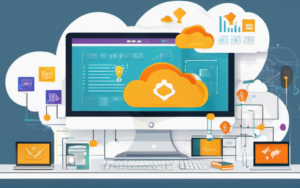Cloud computing has revolutionized the way businesses operate, providing access to on-demand resources and services, from storage and computing power to software and analytics. This transformative technology continues to evolve at a rapid pace, fueled by innovative advancements and changing business needs. As we look ahead, understanding the current trends shaping the future of cloud computing is crucial for businesses to stay ahead of the curve and leverage its potential to maximize growth and efficiency.
The Future of Cloud Computing
Introduction
The cloud computing landscape is constantly evolving, driven by technological advancements and the increasing adoption of cloud services across industries. To navigate this dynamic environment, it’s essential to understand the current trends shaping the future of cloud computing.
Current Trends Shaping the Future
Increased Adoption of Cloud Services
The cloud computing adoption trends show a clear upward trajectory. More and more businesses are embracing cloud services to streamline operations, enhance agility, and reduce IT costs. According to Gartner, by 2025, 95% of new digital workloads will be deployed on cloud platforms. [1] This widespread adoption is fueled by the numerous benefits cloud services offer, such as scalability, flexibility, and cost-effectiveness.
Growth of Edge Computing
Edge computing is emerging as a crucial component of the cloud computing landscape. It brings computation and data storage closer to the users, enabling faster processing and reduced latency. This is particularly beneficial for applications requiring real-time data processing, such as Internet of Things (IoT) devices, autonomous vehicles, and augmented reality. [2]
Advancements in Artificial Intelligence (AI) and Machine Learning (ML)
AI and ML are transforming various industries, and cloud computing plays a pivotal role in enabling their widespread adoption. Cloud platforms provide the infrastructure and resources required to develop, train, and deploy AI and ML models. The integration of these technologies with cloud computing will lead to more intelligent applications and automated processes, further enhancing business efficiency and innovation.
Focus on Security and Compliance
As businesses rely more heavily on cloud services, security and compliance are paramount. Cloud providers are investing heavily in robust security measures and compliance certifications to ensure the protection of sensitive data and meet regulatory requirements. The focus on security and compliance will continue to be a driving force in the future of cloud computing, fostering trust and confidence among users.
Predictions for the Future
Hybrid and Multi-Cloud Environments
Hybrid and multi-cloud environments are becoming increasingly popular as businesses seek to optimize their cloud strategies. This approach combines public, private, and edge clouds to leverage the benefits of each while addressing specific needs and requirements. Businesses can leverage different cloud providers for different workloads, enhancing flexibility and mitigating vendor lock-in. [3]
Serverless Computing
Serverless computing is gaining traction, offering a pay-per-use model for running applications without managing servers. This approach simplifies development and deployment, allowing businesses to focus on building applications while leaving infrastructure management to cloud providers. Serverless computing is expected to become more prevalent, further reducing operational overhead and enabling faster innovation. [4]
Cloud-Native Applications
Cloud-native applications are designed specifically for cloud environments, leveraging microservices architecture, containers, and other cloud technologies. This approach enables scalability, resilience, and faster development cycles, making cloud-native applications ideal for modern businesses seeking agility and innovation. [5]
Increased Automation and Orchestration
Cloud automation and orchestration tools are streamlining cloud operations, enabling businesses to manage resources, deploy applications, and monitor performance more efficiently. The increasing adoption of automation will lead to greater efficiency, reduced errors, and improved scalability in cloud environments. [6]
Focus on Sustainability
Sustainability is becoming a critical factor in the cloud computing industry. Cloud providers are investing in renewable energy sources and energy-efficient data centers to reduce their environmental impact. This focus on sustainability will become increasingly important as businesses strive to minimize their carbon footprint and operate ethically. [7]
The future of cloud computing is bright, filled with exciting possibilities and innovative technologies. By staying informed about current trends and predictions, businesses can position themselves to leverage the transformative power of cloud computing and achieve their goals.




